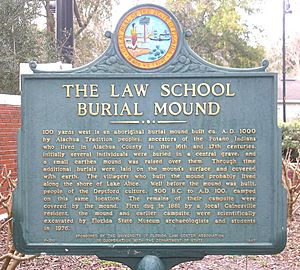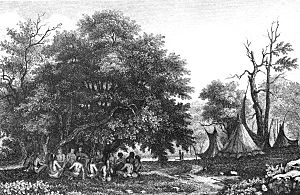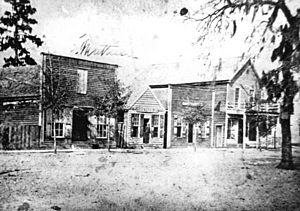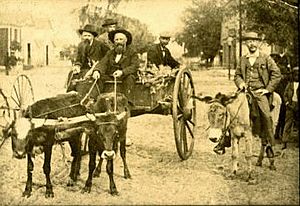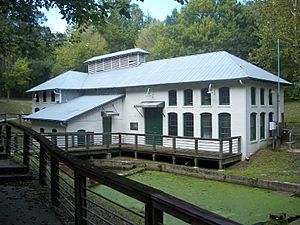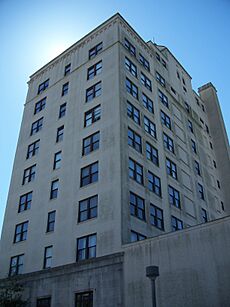History of Gainesville, Florida facts for kids
The city of Gainesville, Florida, in the USA, became an official city in 1869. It is known for its history, natural beauty, and as the home of the University of Florida.
Contents
Early People and Cultures
Quick facts for kids History of Florida |
|
|---|---|
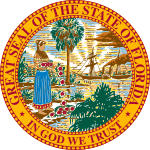
The seal of Florida reflects the state's Native American ancestry
|
|
| Historical Periods | |
| Pre-history | until 1497 |
| Spanish Rule | 1513–1763 |
| British Rule | 1763–1783 |
| Spanish Rule | 1783–1821 |
| U.S. Territorial Period | 1822–1845 |
| Statehood | 1845–present |
| Major Events | |
| American Revolutionary War | 1775–1783 |
| War of 1812 | 1811–1814 |
| First Seminole War | 1817–1818 |
| Capitol moved to Tallahassee |
1824 |
| Second Seminole War | 1835–1842 |
| Constitutional convention | 1838 |
| Third Seminole War | 1855–1858 |
| Ordinance of Secession | 1861 |
| Civil War | 1861–1865 |
| 3rd Constitution | 1865 |
| Reconstruction | 1865–1868 |
| 4th Constitution | 1868 |
| 5th Constitution | 1885 |
| Great Migration | 1910–1930 |
| Land Boom | 1925–1929 |
| 6th Constitution | 1968 |
| Gore v. Harris 2000 Presidential Election |
2000 |
| Timeline | |
Around 12,000 years ago, early people called Paleo-Indians lived in Florida. We don't know if they had permanent homes in what is now Gainesville. However, tools and other signs show people were definitely here. After the ice age ended, Florida became wetter. This meant people didn't have to move around as much to find water. They started living in bigger camps for longer periods. Camps from this time have been found near Paynes Prairie, which is very close to Gainesville today.
Deptford and Cades Pond Cultures
Later, people developed more complex ways of living and started farming. Archaeologists call this the Deptford culture (2500–100 BC). A Deptford culture campsite was found under a later mound at the University of Florida. Around the year 1 AD, Deptford people moved closer to Gainesville. They wanted to use the wetlands near Paynes Prairie and northern Orange Lake. These people became known as the Cades Pond culture.
Alachua Culture and Timucua People
Around the 7th century, new people arrived, likely from Georgia. They were called the Alachua culture. Most of their villages have been found in what is now Alachua County. The burial mound on the UF campus was built around 1000 AD by Alachua culture people. They probably lived near Lake Alice.
Alachua culture villages grew and formed groups. These groups were connected by forest trails. Many of these trails are still used as paved roads today. Some of these village groups were in present-day Gainesville. They were found near the Devil's Millhopper and Moon Lake. Other groups were northwest and north-central of Paynes Prairie, and west of Newnans Lake.
When Europeans first arrived, the Potano people lived in this area. They were a Timucua chiefdom, meaning they were led by a chief. The Potano people were descendants of the Alachua culture. Their main town was in what is now the San Felasco Hammock Preserve State Park, northwest of Gainesville.
European Arrival and Changes
In August 1539, Hernando de Soto and his army passed through Gainesville. This was at the start of their four-year journey through the southeastern United States. They stayed in a village called Utinamocharra. This village was in a group of settlements east of Moon Lake, at the edge of present-day Gainesville.
The Native Americans had not been exposed to European diseases. Because of this, their numbers dropped greatly after Europeans arrived. The Spanish also fought against native revolts, which further reduced the population.
Spanish Missions
The remaining Timucua people became Catholic. They were organized into missions led by Franciscan priests. The Mission San Francisco de Potano was the first mission with a resident priest west of the St. Johns River. It was founded in 1606 at the southern edge of today's San Felasco Hammock Preserve State Park.
Two other missions, Santa Ana and San Miguel, were in or near Gainesville. They were south of San Francisco and a day's walk away. These missions are thought to be in the group of villages east of Moon Lake. Spanish and Indian items from the Mission period have been found there. Santa Ana is believed to be where Utinamocharra was located. In 1606, a friar heard stories from the chief about how De Soto's men had treated him cruelly when he was a boy. The main town of Chief Potano was moved during this time. It moved from Orange Lake to the area near the Devil's Millhopper, which is now inside Gainesville.
End of the Missions
In the early 1700s, raiders from Carolina and their Yamasee Indian allies attacked the area. They killed or captured almost all the remaining native people. The governor of Spanish Florida said that 10,000 to 12,000 native Floridians were taken as slaves. The few Timucua who were left fled and ended up near St. Augustine.
Spanish colonists started raising cattle in the Paynes Prairie area. They used Timucua labor for this. The largest ranch was called La Chua. This name combines the Spanish word "La" (meaning "the") with the Timucuan word "Chua" (meaning "sinkhole"). Even though La Chua was destroyed by the raiders, the ranch gave its name to the Alachua band of the Seminole tribe. These Seminole people settled in the region in the 1700s, led by the great chief Ahaya the Cowkeeper.
From 1763 to 1784, what is now Gainesville was part of the British colony of British East Florida.
Founding of Gainesville
Gainesville was created to be the new county seat for Alachua County. This was because a new railroad line was planned. The Florida Railroad Company wanted to build a line from Cedar Key to Fernandina Beach. In 1853, county residents decided to move the county seat from Newnansville. They chose the name Gainesville. A spot on Black Oak Ridge, where the railroad was expected to cross, was chosen in 1854. The new town was named after General Edmund P. Gaines. He was a commander of the U.S. Army in Florida during the Second Seminole War. The railroad reached Gainesville in 1859. It passed six blocks south of the courthouse.
Some people say Gainesville was first called Hogtown. However, Hogtown was actually an older settlement from the early 1800s. It was located near what is now Westside Park. A historical marker there shows Hogtown's location. Hogtown Creek, which flows through Gainesville, is named after this village. Hogtown continued to exist even after Gainesville was founded. A map from 1864, based on surveys from 1855, shows both towns.
Two people from Hogtown helped create Gainesville. William Lewis, who owned a plantation in Hogtown, helped gather votes for a new town. He hoped the new town would be named Lewisville. Tillman Ingram, who also owned a plantation and sawmill in Hogtown, helped by offering to build a new courthouse cheaply. People from Newnansville were unhappy about losing the county seat. They called the new town site "Hog Wallow" because it was between Hogtown and Paynes Prairie. The old Hogtown area became part of Gainesville in 1961.
A town site of about 103 acres was bought for $642.51. The County Commission ordered the sale of lots in 1854. However, no deeds were recorded until 1856. A courthouse was built in Gainesville in 1856. The county seat then officially moved from Newnansville. A jail was built in 1857. A public well and pump were also installed that year. Property values quickly went up. A city block bought for $14.57 in 1857 sold for $100 in 1858. The railroad from Fernandina reached Gainesville in 1859. It connected to Cedar Key the next year. By that time, there were eight or nine stores and three hotels around the courthouse square.
Civil War Times
In the 1850s, many people in Gainesville supported leaving the Union. Half of the white residents in Gainesville were from South Carolina, where this idea was very strong. Most other white residents were also from Florida or other Southern states. Another reason for this feeling was fear of black people. Most black people in Alachua County were slaves, though few lived in Gainesville itself. John Brown's raid on Harpers Ferry in 1859 scared white residents in Gainesville. This led them to form a militia company called the Gainesville Minutemen.
The Gainesville Minute Men joined the First Florida Regiment after Florida left the Union. Several more companies were formed in Gainesville and Alachua County during the Civil War. During the war, Gainesville was a place where the Confederate government collected food from the area. A small post called Fort Lee, on the east side of Gainesville, was where men joined the Confederate States Army.
Fighting happened in Gainesville twice. On February 15, 1864, a small Union group took over Gainesville. Some Confederate soldiers tried to push them out but were defeated in a street battle. This Union group was part of a larger invasion of Florida. That invasion was defeated at the Battle of Olustee five days later. The Union troops did not destroy property during this raid. They did give food to the residents, who were facing shortages. Six months later, on August 17, 1864, 265 Union troops and 15 "loyal Floridians" reached Gainesville. They stopped east of town to eat and care for their horses. A small local defense group of 30 to 40 older men and boys attacked the Union camp. They were easily driven away. The Union troops then started looting the town. While they were spread out, a large number of Confederate troops were seen approaching. The Union troops fought for an hour and a half. But they were finally forced out of Gainesville with many losses.
After the Civil War
After the Civil War, the 3rd United States Colored Troops stayed in Gainesville for several months. This encouraged freed men (formerly enslaved people) to settle there. At the same time, black farm workers were brought from Georgia and South Carolina. They were needed to harvest a large cotton crop. But heavy rain ruined the cotton, leaving the new arrivals without work. Black residents soon outnumbered white residents in Gainesville. In 1860, Gainesville had 223 white residents.
White residents quickly started political life again in Florida after the war. Gainesville became a city in 1866. However, the city government was weak and did not meet regularly. When military control was put in place over Florida in 1867 as part of Reconstruction, the state government required all cities to re-incorporate. Gainesville did so in 1869. During Reconstruction, black residents in Gainesville were elected to state and local government jobs. However, by the 1890s, most black people had lost their right to vote.
After the Civil War, the city grew as an important place for shipping cotton. Florida produced more Sea Island Cotton in the 1880s than any other state. Gainesville was the main shipping point for cotton in Florida. Two more railroads reached Gainesville by the 1880s. Citrus fruits and vegetables also became important local crops. However, the citrus industry ended when severe freezes in 1894–95 and 1899 destroyed the crops. Citrus growing was mostly stopped in the area. Phosphate mining and lumbering became important parts of the local economy. A manufacturing area grew south of downtown, near the railroads.
Education and Religion
The first school for black people in Gainesville was the Union Academy. It was started in 1866 by the Freedmen's Bureau to educate formerly enslaved people. White residents in Gainesville were against education for black people. They treated the teachers at the school badly. Boys would even throw things into the classrooms. By 1898, the school served 500 students. It stayed open until 1929.
White students only had private schools before 1869. These included the East Florida Seminary, which moved from Ocala in 1866. It joined with the Gainesville Academy, founded in 1856. Even after a public school system was started in Alachua County, most white children went to private schools. The Union Academy was open for more of the year, and its teachers were paid better than those in public schools. Public education was not well-funded into the 1880s. Classes had to meet in old houses or rented rooms. The school year for public schools was as short as three months in some years. The first public school building was built in 1885. The Gainesville Graded and High School opened in 1900. It had twelve classrooms and an auditorium. Most private schools closed soon after. The county school board also gave some money for the Union Academy.
In the early years of Gainesville, there was no special church building. A church built in 1859 by Presbyterians was shared by traveling preachers of different faiths until 1874. The Methodist church in Gainesville stopped during the Civil War. A church they had built was used by a black congregation after the war. Several white Protestant groups formed churches in the 1870s. Catholics, who had been holding services in homes for 25 years, built a church in 1887. Jewish families started moving to Gainesville in the late 1860s. A Jewish cemetery was started in 1872. However, there was no synagogue in Gainesville until 1924.
City Life and Politics
Gainesville was a rough town after the Civil War and into the early 1900s. White and black people often carried guns. Gunshots were often heard at night. Killings and serious injuries happened frequently. The city had only one police officer until well into the 1900s. This was not enough to handle the violence. A group of citizens allowed by the city council also did little to stop the violence. Punishments for crime included public executions, lashes, and fines.
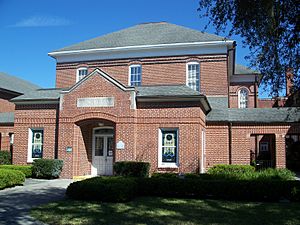
A volunteer fire department was started in 1882. But it could not stop several fires in 1884. These fires burned most of the wooden buildings in downtown Gainesville. The burned buildings were replaced with brick ones. A brick courthouse replaced the old wooden one in 1885. Public services were slowly added to the city in the late 1800s. Gas lines were installed in 1887, water in 1891, and telephones and electricity later in the 1890s. By 1900, Gainesville was the seventh largest city in Florida. It had over 3,600 residents.
The Republican Party remained strong in Gainesville even after Reconstruction ended in 1876. This was because many black people and Northern white people had moved there after the Civil War. Some Southerners also joined the Republican Party. Alachua County was one of the few counties in Florida won by the Republican Party in the election of 1880. In the 1880s, Republicans and Democrats found a way to work together. In the 1883 election, most city races were won by large majorities. Both Republicans and Democrats, white and black, were elected. However, there was tension within the Republican Party between black people and Northern white people. By 1885, more white people from northern states arrived, and some black people left. This gave Gainesville a white majority. In 1889, the Florida Legislature made it harder for black people to vote. They added a poll tax and a reading test. This stopped most black people from voting. Some black people switched to the Democratic Party. This further weakened the Republicans. The Republican Party stopped being a major force in Gainesville politics in the 1890s.
20th Century Growth
Big changes came to Gainesville in the early 1900s. Citizens felt the city did not have enough money or power to provide needed services. They asked the state government to give Gainesville a new city plan. In 1905, it did, also making the city limits larger. The city offered its first bond issue (a way to borrow money) that same year. Money from these bonds was used to start a sewer system and pave important streets. At first, they used crushed rock, and after 1910, they used bricks. When private companies could not provide enough electricity, the city built its own power plant. It started working in 1914.
University of Florida Arrives
Another big event in 1905 greatly affected Gainesville's future. At that time, Florida had eight colleges. The state government was worried about rising costs and colleges offering the same classes. So, they passed the Buckman Act. This law combined the eight schools into four separate schools. One of these was the University of the State of Florida (renamed University of Florida in 1909) for white men. Gainesville competed with Lake City to get the university. Gainesville offered free water, 500 acres of land west of the city, and $40,000 cash. They also offered to buy the East Florida Seminary site for $30,000. The fact that Alachua was a dry county (meaning it banned most alcohol sales) was also seen as a good point for Gainesville. The state chose Gainesville, which caused the biggest celebration in the city's history.
The university opened with 136 students in the fall of 1906. For its first ten years, the school was in a rural area. It was connected to downtown Gainesville by only one crushed rock road. The school had to close its gates at night to keep cows out. Buildings at the university were first built with state money. But in 1919, the city gave $1,000 for a new gym. This helped bring the New York Giants baseball team to town for spring training. As the university grew, businesses spread west along University Avenue. New neighborhoods were built near the campus.
The city faced challenges as it grew in the early 1900s. For many years, the city's only water supply was Boulware Springs. But it reached its limits. The city could no longer connect new neighborhoods to city services. A bond issue was needed to drill a well and build a water tower. A fire house was built in 1903. The fire department was updated, replacing its last horses with motorized equipment in 1913. However, the department remained a volunteer group until the 1920s.
Gainesville's economy was still mostly farming. Gainesville was a major shipping point for cotton. But the industry was ruined by the boll weevil insect in 1916–18. After that, cotton was no longer grown in the area. Truck farming (growing vegetables for market) became important in north central Florida. Large shipments of vegetables and melons went from Gainesville to markets in the northern US. Phosphate mining continued to be important, though it started to decline. Industries like processing naval stores (pine products) and making fertilizer grew in Gainesville. World War I greatly affected Gainesville's economy. Markets in Europe, especially Germany, were cut off by the war. Phosphate mining and the naval stores industry went into a slump. This was made worse by the loss of cotton processing and shipping.
Boom and Bust Times
Gainesville shared in the national economic boom after World War I. In 1925, Gainesville was caught up in the land boom that started in Miami Beach. New neighborhoods were planned and sold at auction. Agreements to buy property were sold and resold at higher and higher prices. Almost 100 real estate brokers and agents registered in Gainesville on the first day licenses were required. Plans were made to build a modern, first-class hotel in Gainesville. After a false start, a developer named W. McKey Kelly proposed a ten-story, 120-room hotel. Construction on the Hotel Kelly, also known as the Dixie Hotel, began in 1926. But Kelly ran out of money before it was finished. The collapse of the land boom ended the project. The unfinished hotel sat empty for over ten years. Then, a federal grant and private donation allowed it to be completed as the Seagle Building.
Glen Springs got the first concrete swimming pool in Gainesville in the mid-1920s. It was a popular place for fun for over 40 years.
Changes in city government happened in the 1920s. The city changed its plan to add a city manager. The police force grew from three men to nine. A desk sergeant was available to answer the phone 24 hours a day. A county hospital opened in Gainesville in 1928. More streets were paved, using asphalt instead of bricks. Growing demand for electricity led the city to consider buying electricity from a private company. But voters passed a change to the city's plan, forbidding such a deal. With a growing population, schools became too crowded. Gainesville High School opened in 1926 and expanded two years later. The old Gainesville Graded and High School became an elementary school. Lincoln School, offering 12 grades for African-Americans, opened in 1923. It replaced the Union Academy, which had served African-American students since 1867.
The Ku Klux Klan became active in Gainesville in the early 1920s. Like elsewhere, it was against black people, Jewish people, and Catholic people. It claimed to support good morals. In one incident, a worker was taken from his job late at night and badly beaten. A police officer tried to help but stopped when guns were shown. City officials seemed to approve of the incident. Former mayor William Reuben Thomas spoke out against it. He asked the mayor and police chief, who seemed to be Klan members, to resign. But nothing changed. The Klan also objected to a Catholic priest who started a drama club at the University. In 1923, Catholic priests were officially banned from all state college campuses.
The collapse of the land boom in 1925–1926 was not as bad in Gainesville as in southern Florida. But it did slow down the local economy. As a result, the Wall Street Crash of 1929 was not felt as strongly as in many other places. The city of Gainesville remained financially stable during the Great Depression. Unemployment was lower than in most of the country. Farming continued to be a main part of the local economy. In 1922, tung trees were planted in Alachua County. Gainesville became the center of tung oil production in the United States. Tung oil had only been available from China before. Both tung oil and tung tree seeds were shipped around the world from Gainesville. The University of Florida, with about 1,000 employees and 2,000 students, helped keep the local economy steady during the Depression. In the mid-to-late 1930s, various New Deal programs brought money and jobs to Gainesville. Utility lines were extended, streets paved, and sidewalks installed. The Seagle Building was finished and used by the University of Florida. An airport, Gainesville's first, was built.
World War II and Beyond
World War II brought more people and economic growth to Gainesville. Even before the United States entered the war, the opening of Camp Blanding affected Gainesville. Soldiers on leave visited the city, and officers rented homes for their families. The airport was improved and taken over by the Army Air Corps as the Alachua Army Airbase. Farming grew, and local businesses received contracts to make military supplies. Building construction also increased. The hospital was expanded with money from the federal government. The university was used to train soldiers, air cadets, and officers.
The end of World War II brought even more growth to Gainesville. The G.I. Bill allowed war veterans to attend college. Enrollment at the University of Florida greatly increased. More than half of the approximately 9,000 students at the university in 1946–47 were veterans. Many veterans had families, which made housing in the city very tight. The university became co-educational in 1947, admitting over 800 women. Gainesville's population doubled from 1940 to 1950. Construction and jobs at the university became more important to the city's economy. The city's power plant was not enough for the demand. The federal government had required the city to buy electricity from private companies during World War II. After voters again rejected a plan for the city to buy electric power wholesale, the city began a major expansion of its own power generation. The water and sewer systems were also greatly expanded. The airport was returned to the city, and regular passenger flights started in 1950. The police department grew from about 10 officers in the 1930s to 40 by 1950. Also in 1950, the old system of named streets was replaced by a system of numbered streets divided into quadrants.
The fast growth of Gainesville put a strain on the public schools. When residents voted against plans to borrow money for school construction, the school board got extra barracks from army bases to use as temporary classrooms. Newer residents helped pass school bond issues starting in the 1950s. The return of veterans to Gainesville and the growth of the university also began to influence politics in Gainesville. In the 1930s, land ownership and political power in Gainesville had become held by fewer people. Veterans returning to the city after World War II found it hard to join the financial and political inner circles. University faculty and staff had been well-involved in the community before the war. But the growth after the war brought in many faculty who were unhappy with the political situation in Gainesville. To avoid problems with local politicians, J. Hillis Miller, the university president from 1947 to 1953, stopped university faculty and staff from taking part in local politics.
During the 1960s, Gainesville became a center for college activism. It was called "The Berkeley of the South" by a professor at the time. The city was involved in the Gainesville Eight case in the 1970s. In this case, eight activists were accused of planning to violently disrupt a political convention. After they were found not guilty, activism slowed down. But it rose again in the mid-1980s. The University of Florida became the state's main spot for anti-apartheid activism.
In 2010 and 2011, a local church, Dove World Outreach Center, gained attention. It was involved in anti-sharia law campaigns and Quran burnings. It also promoted the "Innocence of Muslims" movie trailer and anti-mosque campaigns.
After a rally in Charlottesville, Virginia, a Confederate monument from 1904 was removed from downtown Gainesville. This happened on August 14, 2017, by the United Daughters of the Confederacy.
Timeline of Gainesville
Before the 20th Century
- 1824 – Hogtown, a village where Seminoles raised hogs, became empty.
- 1830 – Hogtown was established.
- 1853 – Gainesville was established, named after U.S. military officer Edmund P. Gaines.
- 1854 – The main office of Alachua County moved to Gainesville from Newnansville.
- 1856 – A school was built.
- 1858 – Gainesville Academy was founded.
- 1859 – Florida Railroad began operating.
- 1860 – Population: 269.
- 1864
- February 14–15: Gainesville was taken over by Union forces, and a small fight happened.
- August 17: The Battle of Gainesville was fought; Confederates won.
- 1865 – New Era newspaper began publishing.
- 1866 – Union Academy opened.
- 1867 – East Florida Seminary moved to Gainesville from Ocala.
- 1869 – The town of Gainesville became an official city.
- 1884
- A fire occurred.
- The City of Alachua was established nearby.
- 1886 – Another fire occurred.
- 1890
- The Daily Sun newspaper was publishing.
- Population: 2,790.
- 1891 – A "public water system" began operating.
- 1900
- The Gainesville High School building was constructed.
- Population: 3,633.
20th Century
- 1901 – William Reuben Thomas became mayor.
- 1906 – The University of the State of Florida moved to Gainesville from Lake City.
- 1907
- Gainesville became a city.
- The University's Agricultural Experiment Station was established.
- 1910
- The Thomas residence was built.
- Population: 6,183.
- 1911 – The University's Florida Gators football team became active.
- 1912 – The University's Florida Alligator newspaper began publishing.
- 1914
- The University's Cadet Band was formed (later Fightin' Gator Marching Band).
- The first public power plant was completed, named the Downtown Power Plant.
- 1917 – The Florida State Museum was established.
- 1918 – Gordon Tison became mayor.
- 1925 – "Tung oil production began."
- 1928
- WRUF radio began broadcasting.
- Hotel Thomas was in business.
- 1930
- The University's Florida Field stadium opened.
- Population: 10,465.
- 1935 – An airport was built.
- 1940 – Population: 13,757.
- 1950
- Gainesville Drive-In cinema was in business.
- Population: 26,861.
- 1958 – WUFT (TV) began broadcasting.
- 1960 – Population: 29,701.
- 1961 – Gainesville added the former site of Hogtown.
- 1964 – The University's Institute of Food and Agricultural Sciences was established.
- 1966
- Santa Fe Community College was established.
- White Theatre (cinema) was in business.
- 1967 – Alachua County Historical Society was founded.
- 1970 – Population: 64,510.
- 1972 – Santa Fe College Teaching Zoo and Historic Gainesville Inc. were established.
- 1974 – Thomas Center was established.
- 1975 – Alachua County Courthouse was built.
- 1980 – Population: 81,371.
- 1981 – WUFT-FM radio began broadcasting.
- 1988 – Florida Museum of Natural History was active.
- 1989 – Matheson Historical Center was established.
- 1993 – Corrine Brown became a U.S. representative for Florida's 3rd congressional district; Karen Thurman became a U.S. representative for Florida's 5th congressional district.
- 1994 – Matheson Museum opened.
- 2000
- City website went online (around this time).
- Population: 95,447.
21st Century
- 2004 – Pegeen Hanrahan became mayor.
- 2010
- Craig Lowe became mayor.
- Population: 124,354.
- 2013 – Ed Braddy became mayor.
- 2016 – Lauren Poe became mayor.
Images for kids
-
Ku Klux Klan meeting in Gainesville, 1922.


